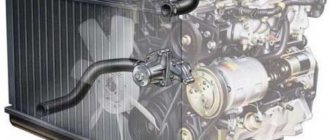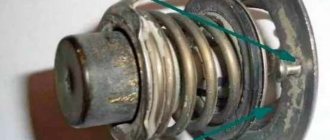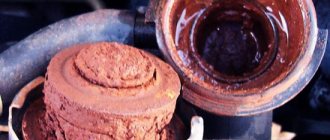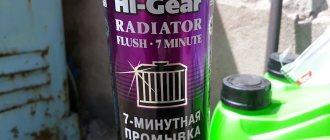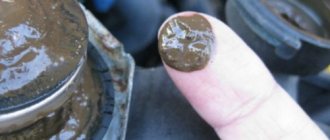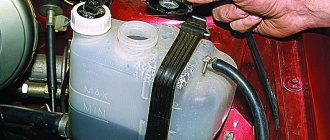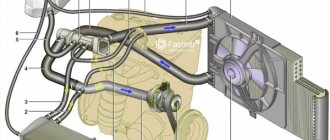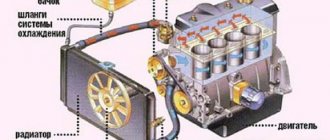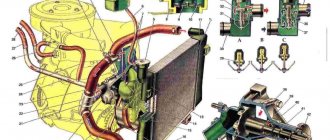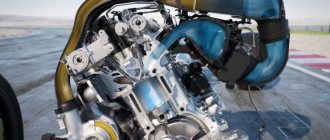Working fluids in a car must be replaced in a timely manner. During operation, contaminants, deposits and metal shavings accumulate in liquids. Also, the liquids themselves tend to lose their protective and other beneficial properties over time. Engine cooling system fluid (antifreeze, antifreeze) is no exception. The main task of this working fluid is to maintain the specified operating temperature of the engine by removing heat as a result of continuous circulation through the cooling system. Also, the coolant (coolant) provides heating to the heater to warm up the interior space of the car.
We also recommend reading the article on how to flush the engine before changing engine oil using a diesel engine as an example. From this article you will learn about when and with what means you need to flush the engine.
An additional function of the coolant is to lubricate and protect parts from corrosion. The fluid contains a package of special additives to lubricate the pump (water pump) and prevent the formation of rust in the cooling jacket of the engine cylinder block. It is recommended to change antifreeze once every 3 years.
Why do you drain coolant?
it is important! The fact that it is time to change the fluid in the system is indicated by a pronounced change in color: if the material has turned brown, it contains a large amount of rust, i.e. antifreeze does not protect the washed surfaces from corrosion, and it needs to be replaced. Other signs of aging of the coolant include the appearance of sediment, cloudiness of the refrigerant, and a jelly-like deposit inside the neck of the expansion tank.
Draining antifreeze may be necessary in the following cases:
- The service life of the coolant has expired. This date is usually indicated on the original packaging;
- Repair work is being carried out, which includes draining the coolant. After completing the repair, it is better to pour new antifreeze into the system;
- On the way, the liquid in the radiator boiled, and I had to add water. As soon as possible, this refrigerant must be replaced with a new one.
What antifreeze should I buy as a replacement?
Coolants are available in different brands and with different performance properties. Which one is right for your car is written in its operating manual.
If such a reminder is missing, pay attention to the following points:
1. Marking . Usually consists of a letter and a number. If the marking contains the letter “A”, the liquid is ready to be poured into the cooling system, if the letter “K” is a concentrate that must be diluted before use. The next number after the letter is a number that indicates at what temperature the liquid can freeze, for example, at -40 °C, -65 °C, and so on. Sometimes another letter is placed after the number, most often M, which indicates the presence of various additives. Some manufacturers indicate only the name and number on the label.
Markings that were first used by Volkswagen are quite common. Antifreeze is distinguished under the designations G11, G12 (G12+, G12++) and G13.
- G11 - antifreezes, usually green in color, with organic and chemical additives added to them;
- G12, G12+, G12++ - antifreezes of different shades of red, they are almost completely organic;
- G13 - purple or yellow antifreeze, belongs to the latest generation of the safest coolants.
It is better not to mix coolants with different characteristics and markings with each other to avoid an unpredictable reaction. If you are in doubt about the right choice, it is better to consult a seller in a specialized store.
2. Manufacturer . It is better to buy coolant from reliable and well-known manufacturers to avoid defects, since low-quality antifreeze can lead to serious engine damage. Such manufacturers as Mobil, Hepu, Liqui Moly, Motul, Lukoil are known on our market.
3. Detection of counterfeits . Even if the label bears the brand of a well-known company, it would not be superfluous to check what quality of liquid is contained in the package. It must meet the following requirements:
- The color must match the marking (usually it is blue), the liquid must be transparent.
- The consistency of a quality product should be similar to vegetable oil and be slippery.
- The label must be glued evenly with GOST and markings indicated on it. It is this feature that distinguishes factory-made antifreezes. Domestic manufacturers also indicate all the necessary information on the label. If you do not find such information on it or it is glued carelessly, it is better not to buy such a liquid.
4. Title . The coolant container may say “antifreeze” or “antifreeze.” Antifreeze is a substance that can remove heat, and antifreeze is a special coolant that is intended for internal combustion engines of cars. It also contains additives with anti-corrosion properties that protect the cooling system and car engine.
How to remove waste fluid from the system
To drain old antifreeze, you need to prepare a special container in advance, in which it will then be convenient to dispose of the consumables. It is impossible to pour waste into the ground, because it contains a large amount of toxins that can cause damage to the environment. To prepare the car for replacing the coolant, it is placed on a flat horizontal platform. This is done in order to remove the maximum possible volume of liquid from the system. The antifreeze is drained by unscrewing the special hole plug located in the lower circuits of the cooling system. If the design does not provide for such a plug, the coolant is removed by disconnecting the lower pipe from the radiator.
Preparation
To understand how to drain the coolant, you need to consider the procedure step by step. First, you need to study the operating instructions for your car. The location of the drain plugs is discussed in detail there.
You will need to prepare a set of keys. You also need to prepare a large container. This can be a basin with a volume of at least 8 liters. You should also make sure you have rags.
First you need to pay attention to the radiator. The work begins with him. Check your owner's manual to find where the coolant drain plug is located for this system. It's usually easy. The drain plug on the radiator tank is usually made of plastic.
Only after this the liquid is drained from the engine. The plug may be on the cylinder block. It is unscrewed with the appropriate key. The work is carried out with a cold engine.
Things to remember
Despite the simplicity of the manipulations associated with replacing antifreeze, following certain rules will allow you to perform them more efficiently and avoid injury during work. First of all:
- Do not drain antifreeze from the cooling system on a hot engine. If the coolant is heated to operating temperature, it means there is high pressure in the system. If you unscrew the drain plug when the engine is not cooled down, you can get burned by the liquid escaping in the form of steam;
- While the engine is cooling, you need to unscrew the cap of the expansion tank, fully open the damper on the heater (if the car has air conditioning, its regulator is also set to maximum), and prepare a container for testing. Slowly unscrew the drain plug and remove the liquid over several minutes. In some cases, this may be sufficient (for example, if previous replacements were carried out according to regulations, and you are confident in the compatibility of the old and new antifreeze).
Is it possible to use ordinary water instead of antifreeze?
Many car drivers often wonder why they need to use antifreeze or antifreeze. Why not use ordinary water. In fact, this issue requires special consideration.
It is acceptable to pour water into the cooling system, but not recommended. With the onset of the winter season, the use of water is strictly prohibited. Factory-made cooling fluid is more suitable for solving this problem. The substance has increased heat transfer and heat capacity, has an anti-corrosion effect, a high temperature for boiling and an extra low temperature for freezing. Water only has good heat transfer, but other characteristics are far from ideal. If used in a car, then the vehicle cannot be operated under high load so that the water does not eventually boil.
When there is a negative temperature outside, the water turns into ice and can rupture the pipes. Water is also the main cause of scale formation. Gradually its concentration increases, and the liquid begins to pass through with difficulty. Use only distilled water and do not mix with antifreeze. The motor will in no way be damaged by the use of water. An interesting fact is that previously they used water with ethylene glycol.
The procedure for draining antifreeze is not difficult, regardless of the model and brand of car. The most important thing is to adhere to the above procedure and take precautions so as not to harm your health. Changing antifreeze is a mandatory procedure that allows you to maintain efficient and stable operation of the cooling system. Otherwise, the motor will begin to overheat and metal surfaces will become deformed. In addition to the appropriate period, it is recommended to fill in antifreeze or antifreeze after installing a new radiator and thermostat. The procedure cannot be performed by a qualified specialist without practical experience, so it is not necessary to waste time visiting the service.
| Tweet |
How to drain coolant correctly and completely
After the refrigerant has stopped flowing from the drain hole, there is usually some waste liquid remaining in the circuit. This is due to the design features and location of individual elements of the cooling system, from which it is impossible to drain the coolant by gravity. To completely remove the old antifreeze, a number of additional steps will be required.
From the cylinder block . The waste partially remains in the cooling channels of the cylinder block, located at a certain angle. To get rid of these residues, a pressure is created in the system that can completely displace the refrigerant. To do this, do the following:
- After waiting until the liquid stops pouring out on its own, leave the drain hole open and tighten the cap of the expansion tank. Then turn on the heater in the cabin to maximum and start the engine;
- let the engine run for 1–2 minutes, no more: an internal combustion engine without antifreeze can quickly overheat. If coolant continues to pour out while the engine is running, after switching on for a short time, the power unit still needs to be turned off and allowed to cool for 20–30 minutes. The procedure is repeated until the waste material stops coming out of the drain hole;
- tighten the plug or replace the pipe.
What additional information may be required ? Draining old antifreeze may have its own nuances for different brands of cars. So, in some cases, a jack is required to completely remove coolant from the cooling system. This tool is used to lift the rear of the vehicle, allowing any remaining coolant to escape through the drain hole located at the front of the vehicle. Another auxiliary means of removing antifreeze can be a compressor connected to the engine cooling circuit. This method is usually chosen in extreme cases, because if you do not calculate the pressure, you can easily damage the plastic elements of the system.
When should you drain the old refrigerant and add new one?
The determining factor here is the service life of the cooler. The standard period for using antifreeze is 3-5 years. For example, ordinary antifreeze may not require replacement for up to two years, and most foreign compounds are suitable for use for 5 years.
Manufacturers often indicate not the period of operation in years, but the mileage during which the antifreeze can maintain its technical characteristics. On average, the figure is 20-60 thousand km. The operating capabilities of the vehicle have an impact here. When the machine is running under load, the coolant use time may be shorter.
To accurately understand when antifreeze needs to be replaced, you should evaluate its appearance. When the refrigerant changes its initial color to brown or gray, foam appears, this means that the additives can no longer cope with the assigned tasks, which means it’s time to drain the antifreeze.
How to fill new coolant
When the cooling system is completely cleared of waste material and washed, it is filled with new antifreeze. When adding fresh refrigerant, you should follow the proportions prescribed by the manufacturer (if you dilute the concentrate yourself). It would also be a good idea to check the car’s technical documentation for the amount of antifreeze required. To fill the cooling system with new coolant, you must:
- pour refrigerant into the expansion tank to the max mark;
- screw on the tank cap, start the engine and turn on the heater in the cabin. The pump will begin to distribute the liquid evenly along the circuit. The antifreeze level in the expansion tank will drop noticeably. This indicates that the refrigerant is gradually filling the entire system;
- turn off the engine when the level drops to the min mark. Add coolant to the maximum and start the engine again. The procedure is repeated until the liquid column in the tank stabilizes.
Drain plug with neodymium magnet
Of course, the oil filter protects the lubricating fluid from contamination by debris and metal shavings. However, the cleaning element does not work flawlessly, and still some amount of debris ends up in the engine oil. This leads to wear and tear of the main components and assemblies of the car engine. Well, engine wear casts doubt on the ability to drive such a car.
To solve this problem, magnetic drain plugs were designed. A neodymium magnet is installed on the tip of such an element - small in size, but quite powerful. It attracts metal shavings from the oil (the properties of the substance allow this to be done even with boiling oil). As a result, the performance of the engine and the vehicle as a whole improves.
Of course, a magnetic plug costs much more than an ordinary one, but still the price of a part with a neodymium tip cannot be compared with the cost of a major overhaul of a car’s power unit.

